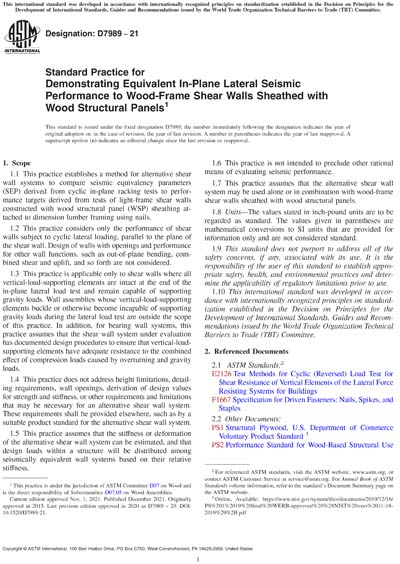Most recent
ASTM D7989-21
Standard Practice for Demonstrating Equivalent In-Plane Lateral Seismic Performance to Wood-Frame Shear Walls Sheathed with Wood Structural Panels
1.1This practice establishes a method for alternative shear wall systems to compare seismic equivalency parameters (SEP) derived from cyclic in-plane racking tests to performance targets derived from tests of light-frame shear walls constructed with wood structural panel (WSP) sheathing attached to dimension lumber framing using nails.
1.2This practice considers only the performance of shear walls subject to cyclic lateral loading, parallel to the plane of the shear wall. Design of walls with openings and performance for other wall functions, such as out-of-plane bending, combined shear and uplift, and so forth are not considered.
1.3This practice is applicable only to shear walls where all vertical-load-supporting elements are intact at the end of the in-plane lateral load test and remain capable of supporting gravity loads. Wall assemblies whose vertical-load-supporting elements buckle or otherwise become incapable of supporting gravity loads during the lateral load test are outside the scope of this practice. In addition, for bearing wall systems, this practice assumes that the shear wall system under evaluation has documented design procedures to ensure that vertical-load-supporting elements have adequate resistance to the combined effect of compression loads caused by overturning and gravity loads.
1.4This practice does not address height limitations, detailing requirements, wall openings, derivation of design values for strength and stiffness, or other requirements and limitations that may be necessary for an alternative shear wall system. These requirements shall be provided elsewhere, such as by a suitable product standard for the alternative shear wall system.
1.5This practice assumes that the stiffness or deformation of the alternative shear wall system can be estimated, and that design loads within a structure will be distributed among seismically equivalent wall systems based on their relative stiffness.
1.6This practice is not intended to preclude other rational means of evaluating seismic performance.
1.7This practice assumes that the alternative shear wall system may be used alone or in combination with wood-frame shear walls sheathed with wood structural panels.
1.8Units - The values stated in inch-pound units are to be regarded as standard. The values given in parentheses are mathematical conversions to SI units that are provided for information only and are not considered standard.
1.9This standard does not purport to address all of the safety concerns, if any, associated with its use. It is the responsibility of the user of this standard to establish appropriate safety, health, and environmental practices and determine the applicability of regulatory limitations prior to use.
1.10This international standard was developed in accordance with internationally recognized principles on standardization established in the Decision on Principles for the Development of International Standards, Guides and Recommendations issued by the World Trade Organization Technical Barriers to Trade (TBT) Committee.
Content Provider
ASTM International [astm]






